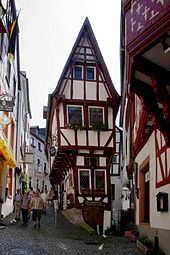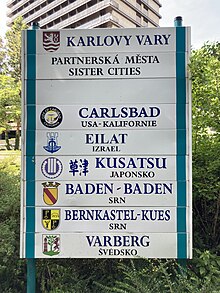Bernkastel-Kues
Bernkastel-Kues | |
|---|---|
 Bernkastel-Kues | |
Location of Bernkastel-Kues within Bernkastel-Wittlich district Bernkastel-Wittlich | |
| Municipal assoc. | Bernkastel-Kues |
| Government | |
| • Mayor (2019–24) | Wolfgang Port[1] (CDU) |
| Area | |
| • Total | 23.66 km2 (9.14 sq mi) |
| Elevation | 110 m (360 ft) |
| Population (2022-12-31)[2] | |
| • Total | 7,156 |
| • Density | 300/km2 (780/sq mi) |
| Time zone | UTC+01:00 (CET) |
| • Summer (DST) | UTC+02:00 (CEST) |
| Postal codes | 54470 |
| Dialling codes | 06531 |
| Vehicle registration | WIL, BKS |
| Website | www.bernkastel.de |




Bernkastel-Kues (German pronunciation:
Geography
Location
Bernkastel-Kues lies in the Mosel valley, roughly 50 km (31 mi) from Trier. The greatest elevation is the Olymp (415 m above sea level), and the lowest point (107 m above sea level) lies on the Mosel's banks. The municipal area totals 23 657 101 m2, of which 7 815 899 m2 is used for agriculture, thereby making Bernkastel-Kues one of the Middle Moselle's biggest towns by land area.
Neighbouring municipalities
Clockwise from the north, these are
.Constituent communities
Bernkastel-Kues is subdivided into the four
Population structure
Stadtteil (as at 1/2006) |
Inhabitants | Male | Female |
|---|---|---|---|
| Andel | 788 | 378 | 410 |
| Bernkastel | 1087 | 539 | 548 |
| Kues | 4603 | 2121 | 2482 |
| Wehlen | 1262 | 658 | 604 |
Climate
The town lies in a transitional zone between temperate oceanic climate and continental climate. The barrier formed by the Eifel shields Bernkastel-Kues from west winds, putting it in a rain shadow and sometimes subjecting it to a föhn effect.
Yearly
History
The earliest evidence of human habitation (3000 BC) was discovered by archaeologists in Kues. About AD 370, Decimus Magnus Ausonius, the Roman poet and teacher at the Imperial court, wrote his poem Mosella. Adalbero von Luxemburg (d. 1036 or 1037), Provost of the Trier Monastery of St. Paulin, became Lord of Bernkastel in the early 11th century.
In the first half of the 11th century, Bernkastel had its first documentary mention.
At the turn of the 8th century, a geographer described a place called Princastellum. This is said to be evidence of a Roman castellum in the 4th century near today's Landshut castle ruin. Pointing to this are, among other things, fittings and finds of ceramic and iron underneath the castle.
The 12th-century form of the name, Beronis castellum, was a learned re-Latinization, which was related to Adalbero von Luxemburg. Work was begun on the third castle building under the lordship of Archbishop of Trier Heinrich II of Finstingen.
On 29 May 1291, King
In 1401,
In 1505, in an
The Plague raged in Bernkastel in 1627, and in Kues in 1641. In 1692, Castle Landshut fell victim to fire and since then it has been a ruin.
From 1794 to 1814, Bernkastel was a cantonal
The first road bridge between Bernkastel and Kues was built between 1872 and 1874, as was the first
The town in its current form came into being on 1 April 1905 through the merger of the town of Bernkastel with the winemaking village of Kues across the river. In 1926 there arose great unrest among winemakers along the Moselle, and the financial office in Bernkastel and the customs office in Kues were stormed.
On
In 1946, the first democratic elections after the
In 1970, Andel and Wehlen were amalgamated with the town. With administrative reform in
In 1997, the Burgbergtunnel, a traffic bypass, had its festive opening.
Bernkastel-Kues was the host town for the annual Intercamp Camporee for the year 2008. Scouting councils from the USA, Canada, the Czech Republic, Germany, France, and many other European countries attended the event on May 9–11.
In 2000 began the partnership between Bernkastel-Kues and Karlovy Vary in the Czech Republic. In 2005, the town celebrated the centenary of the merger of Bernkastel and Kues, and the municipality became a “climatic health resort” (Heilklimatischer Kurort).
Politics
Town council
The council is made up of 22 council members, who were elected by proportional representation at the municipal election held on 7 June 2009, and the honorary mayor as chairman.
The municipal election held on 7 June 2009 yielded the following results:[3]
| SPD | CDU | FDP | GRÜNE |
UBU (Unabhängige Bürgerunion) | Total | |
| 2009 | 3 | 9 | 4 | 3 | 3 | 22 seats |
| 2004 | 3 | 11 | 3 | 3 | 2 | 22 seats |
Mayors
The honorary mayor is Wolfgang Port (CDU). He was first elected in 2000 and last re-elected in 2019 with 61.6% of the votes.
Port's predecessor, Helmut Gestrich, was mayor beginning in 1994 and was reëlected in 1999, but he resigned the mayoralty on 22 November 2000 after having been linked to the so-called Doerfert Affair (a corruption scandal; its namesake, Hans-Joachim Doerfert, was sentenced to seven years and three months for fraud and breach of trust, although he only served five years).[4]
Coat of arms


The town's arms might be described thus: Quarterly, first and fourth sable a key palewise argent, the wards to chief and sinister, second Or a bear passant of the first, and third Or a crayfish palewise gules, the head to chief.
The arms borne until 1951 were similar, but there were two notable differences:
- The third quarter bore another bear, like the second quarter, but it was turned to sinister (armsbearer's left, viewer's right);
- There was a silver inescutcheon at the fess point (centre) charged with a red cross,[5] (i.e., the arms of the Archbishopric of Trier).
The keys are meant to be the keys of heaven held by
Culture and sightseeing




Worth seeing in Bernkastel is the mediaeval marketplace with its gabled timber-frame houses from the 17th century, foremost among which is the narrow Spitzhäuschen (“Pointed House”) from 1416. Around the St. Michaelsbrunnen (“Saint Michael’s Fountain”) from 1606 gathers a row of well-preserved buildings and also the Renaissance Town Hall from 1608. The Graach Gate is an often visited tourist attraction. Above the constituent community of Bernkastel lie the Castle Landshut ruins, a former summer residence of the Archbishops of Trier that was destroyed by fire on 8 January 1692. It today serves as a popular lookout point over the Moselle valley. Also worth seeing is the only town gate that is still standing, the Graacher Tor (“Graach Gate”).
The town furthermore has several squares at its disposal; beyond the mediaeval marketplace are the Platz am Bärenbrunnen (“Square at the Bear’s Fountain”) and the Karlsbader Platz (“Karlovy Vary Square” – named after the partner town, which is called Karlsbad in
Regular events
- MoselMusikFestival (May to October)
- Weinfest der Mittelmosel (“Wine Festival of the Middle Moselle”, each year on the first weekend in September) – with, among other things, a parade and fireworks
- Christmas market in the mediaeval town. Many local vendors sell everything from mulled wine to handmade trinkets.
- Tage alter Chormusik (“Days of Choir Music”, each year in the week after Easter
- International rowing regatta on the Moselle for the Grüner Moselpokal (“Green Moselle Cup”) in September
- Mittelalter-Spectacel (a mediaeval spectacle, every other year)
- Bernkastel-Kueser Reitertage (“Riding Days”)
- Moselfestwochen (classic music festival)
- Straßenfest (street fair) in the constituent community of Kues
- Tage der offenen Weinkeller (“Open Wine Cellar Days”) in the constituent community of Kues where the winemakers of Kues present and sell their wine in their own wine cellars.
- Annual horse show on the Easter weekend
Economy and infrastructure
Public institutions
Education
- Nikolaus-von-Kues-Gymnasium
- Freiherr-vom-Stein-Realschule
- Hauptschule with all-day school
- Grundschule Kues (Cusanusschule) (primary school)
- Grundschule Wehlen (primary school)
- Professional training schools (Berufsbildende Schulen) with professional school (Berufsfachschule) I and II, upper professional school (Berufsoberschule)
- Hotelfachschule and Höhere Berufsfachschule für Hotelmanagement
- Medizinisches Ausbildungszentrum Moseltal, Fachschule für Physiotherapie (medical training centre, specialization in physiotherapy)
- Burg-Landshut-Schule für Lernbehinderte (for students with learning difficulties)
- Rosenbergschule (special schoolwith focus on holistic development)
Authorities
- Amtsgericht
- Bundesagentur für Arbeit (Federal agency for labour)
- Cusanus-Krankenhaus (hospital, part of CTT Verbundkrankenhaus Bernkastel-Wittlich)
- Dienstleistungszentrum Ländlicher Raum (a winegrowing and oenology, schools teaching in agricultural disciplines, and many other related things, in both advisory and developmental capacities)
- Finanzamt Bernkastel-Wittlich (financial office – branch location)
- Kraftfahrzeugzulassungsstelle Bernkastel-Wittlich (vehicle licensing centre – branch location)
- Polizeiinspektion (police service)
- Verbandsgemeindeverwaltung Bernkastel-Kues (Verbandsgemeinde administration)
- Vermessungs- und Katasteramt (surveying and cadastral office)
- Wasser- und Schifffahrtsamt Trier (water and shipping office – branch location)
- Wasserschutzpolizei (water protection police)
Established businesses
- Mageba, a producer of textile machinery
- Median Kliniken GmbH with its rehabilitation centre, biggest employer in the Bernkastel-Wittlich district
- Moselland eG, biggest winemaking cooperative in Rhineland-Palatinate, turnover: €47,500,000
- Peter Mertes Weinkellerei GmbH, biggest German winery, turnover: €130,000,000 (2004)
Winegrowing


Historically, the most important economic sector has been
Within town limits, the winemaking appellations – Großlagen – Münzlay (Wehlen), Badstube (Bernkastel) and Kurfürstlay (Bernkastel, Kues and Andel) are represented by the following vineyards:
|
|
Transport
Road
Bernkastel-Kues lies on
Rail
Until 31 December 1962, the narrow gauge Moseltalbahn, also called the Saufbähnchen, ran through Bernkastel-Kues. The
Water
Bernkastel-Kues is a stop on Rhine-Mosel cruises. Along the shore of the Mosel are many landing stages from which there are many tours daily.
Notable people

- Nikolaus von Kues(Cusanus) (1401–1464), philosopher, theologian, jurist and astronomer
- Duke of Lorraine, died in Bernkastel
- Hermann Schroeder (1904–1984), composer
- Heiner Thiel (born 1957), sculptor and curator
- Stuart Pigott (born 1960), British, wine specialist, author and journalist
Twin towns – sister cities

Bernkastel-Kues is twinned with:
 Karlovy Vary, Czech Republic
Karlovy Vary, Czech Republic
In popular culture
The first string before the hyphen, "Bernkastel" is the name of a character in the visual novel series Umineko: When They Cry.[8][9]
Panorama
Further reading
- Franz Schmitt: Chronik von Cues. Bernkastel-Kues 1981.
- Franz Schmitt: Bernkastel im Wandel der Zeiten. Trier 1985.
References
- ^ Direktwahlen 2019, Landkreis Bernkastel-Wittlich, Landeswahlleiter Rheinland-Pfalz, accessed 6 August 2021.
- Statistisches Landesamt Rheinland-Pfalz. 2023.
- ^ Kommunalwahl Rheinland-Pfalz 2009, Stadtrat
- ^ Prägende Persönlichkeit verloren volksfreund.de, 30. Mai 2009
- ^ Prof. Hupp, Schließheim; in Deutsche Ortswappen; Bremen: Kaffeehandels-A.G., 1895
- ^ Entry at Heraldry of the World
- ^ Moselwein e. V.
- ^ Goldenarrow7778 (2020-12-19). "The origin of the name Bernkastel". r/umineko. Retrieved 2024-03-31.
{{cite web}}: CS1 maint: numeric names: authors list (link) - ^ "What Does The Name Bernkastel Mean?". Names.org. Retrieved March 31, 2024.
External links
- Town’s official webpage (in German)
- Official webpage in English of Tourism of Bernkastel-Kues in Moselle Valley
- Brief portrait of Bernkastel Archived 2011-06-06 at the Wayback Machine at SWR Fernsehen (in German)
- Constituent community of Andel Archived 2018-01-10 at the Wayback Machine (in German)
- Constituent community of Wehlen (in German)
- Moselfestwochen (in German)



